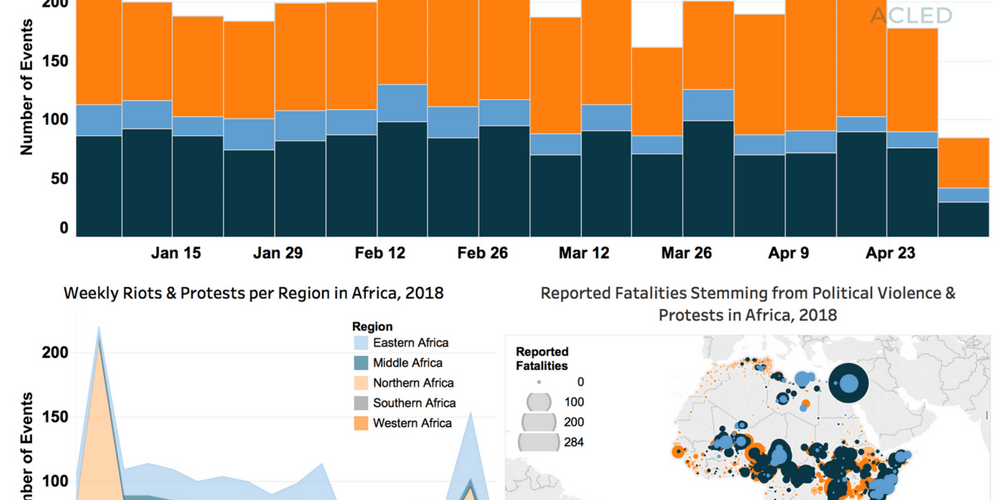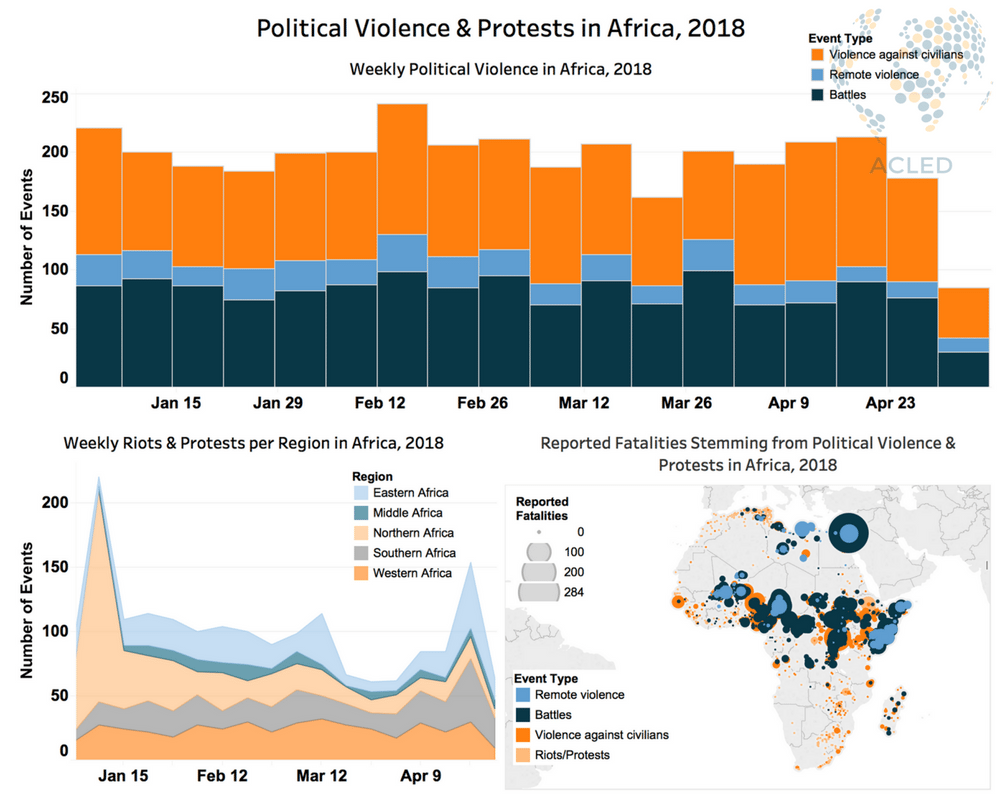Important developments in Africa on the week of April 29th include the major attacks on civilians in central towns in the Central African Republic (CAR) and in the Democratic Republic of Congo (DRC); the alarming tensions along the Mali-Niger border; the first use of weaponised drones in Libya; and the riots in South Africa and Zimbabwe.
Major attacks targeted civilians in central towns in CAR and in the DRC. In both cases, people rioted to denounce the lack of response by the authorities and interactional actors. In CAR, suspected militiamen from the PK5 neighborhood of Bangui attacked the Fatima Roman Catholic church in Bangui on May 1st, in response to the state forces’ attempts to arrest their leader over the past weeks. The attack left around 30 people attending the service killed, including the pastor, and wounded nearly a hundred others. The populations from PK5 reacted angrily to the attacks, with incidents of looting and of setting on fire of mosques in parts of the town, lynching of Muslim civilians, barricading of roads and throwing of stones at the MINUSCA patrols over the three days that followed. In the DRC, unidentified gunmen fired indiscriminately at civilians near a shopping mall in Goma on April 29th, leaving at least seven killed and 18 others injured. The following day, civilians barricaded the road linking Goma to Sake to protest against the police inaction during the incident. In parallel, Fight for Change (LUCHA) activists held protests against the extensive killings and kidnappings in North-Kivu.
In Mali, cycles of revenge killings between communities and armed groups in the border areas between Mali and Niger are raising alarm. On April 29th for instance, gunmen ambushed civilians from the Dawsahak ethnic group in Kamgala, Ansongo cercle (Gao region), as they returned from a weekly market on the Nigerien side of the border. A few days later, in the Anderamboukane commune of Menaka cercle (Gao region), retaliatory attacks opposed the Imghad and Ibogholitane groups. Militants from the Imghad Tuareg and Allies Self‐Defense Group (GATIA) and the Islamic State Greater Sahara (ISGS) were also presumably involved in these attacks. In parallel, the French Barkhane forces launched airstrikes against the ISGS in both Ansongo and Menaka cercles. On the other side of the border, in Niger’s Tillabery region, militants of the Movement for Azawad Salvation (MSA) attacked several camps and wells in the area of Ekrafane between April 26-28th, killing 44 people from the Fulani community.
In Libya, violence has risen again in both Darnah and Sabah districts over the past two weeks. The first uses of weaponized drones in the Libyan conflict have been recorded In Darnah. The Libyan and Emirati military forces launched combined drone/ground attacks against militants of the Shura Council of Darnah Mujahidin (MSCD) south of Darnah over April 30th – May 5th. At the same time, high-intensity clashes have resumed between the Tabu and Awlad Suleiman militias in Sabah. Violence between the two groups has been ongoing since February and shows no sign of abating.
Finally, riots increased in South Africa and Zimbabwe. In South Africa, increasingly violent service-delivery protests have taken place in urban working-class townships in the major metropoles over the past weeks, including in greater Cape Town and Johannesburg. They point to a rising discontent over the municipalities’ inability to provide basic services to the growing working class in these areas. In Zimbabwe, clashes between the supporters of rival candidates of the Zimbabwe African National Union‐Patriotic Front (ZANU-PF) during the party primaries over alleged electoral malpractice reveal important intra-party divisions ahead of the July presidential elections.
Other relevant developments in Africa on the week of April 29th include the resignation of the Gabonese government on May 4th; the mass protests led by the Christian Association of Nigeria over the Fulani violence in Nigeria; continued suicide attacks in Adamawa and Borno states by Boko Haram; and the reports of an upcoming enhanced American military presence in Lower Shabelle of Somalia, evidenced by the setting up of new bases.
AfricaAnalysisCivilians At RiskConflict MonitoringCurrent HotspotsRemote ViolenceRioting And ProtestsViolence Against Civilians







